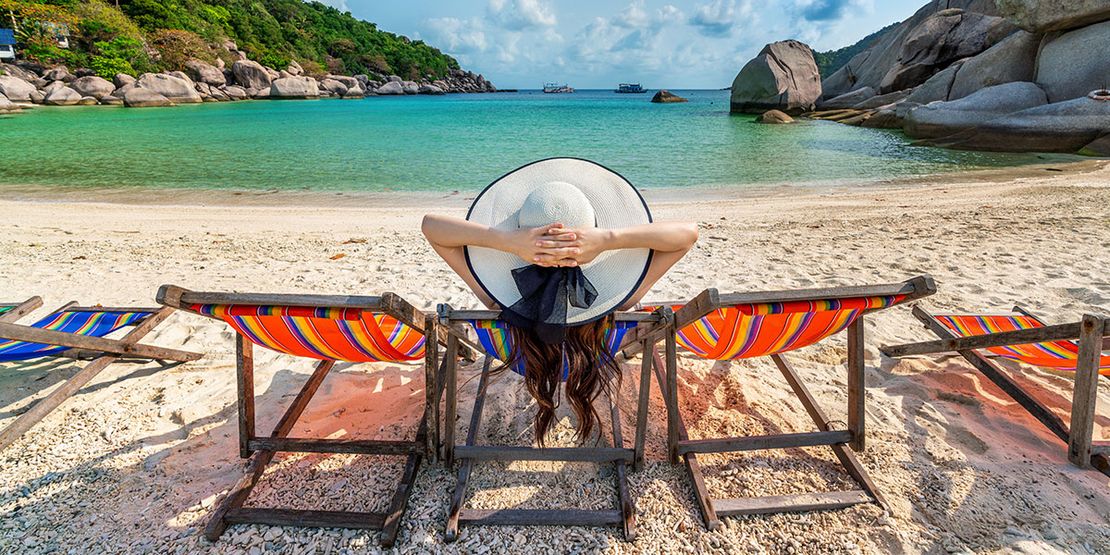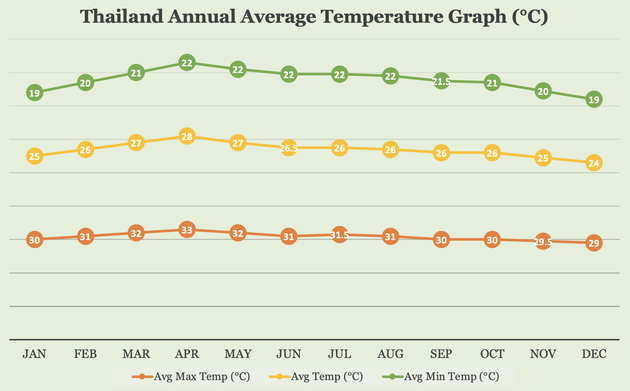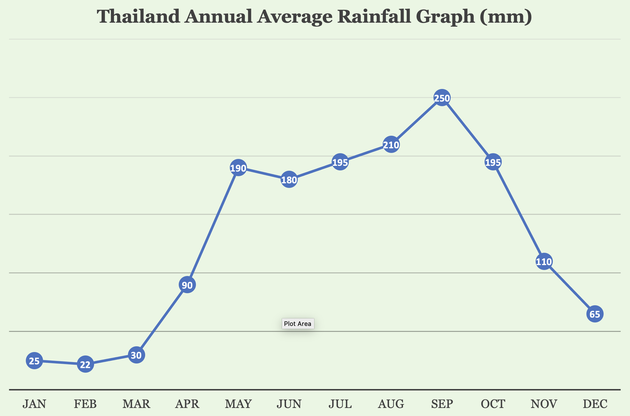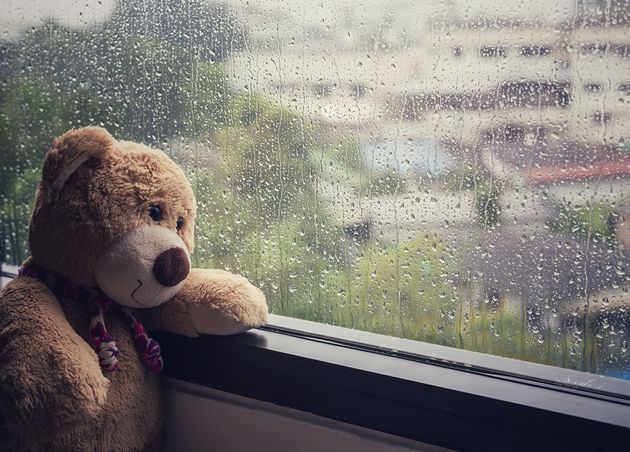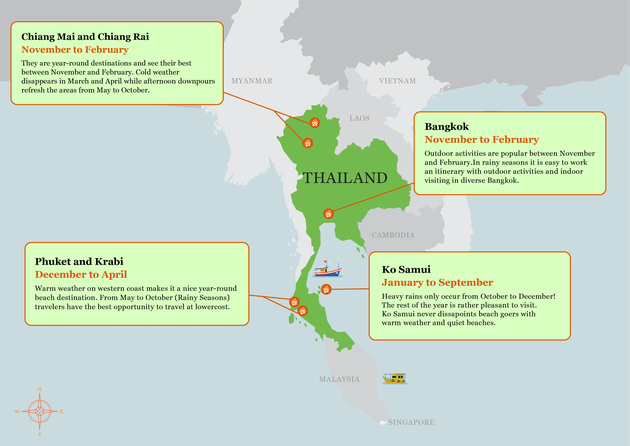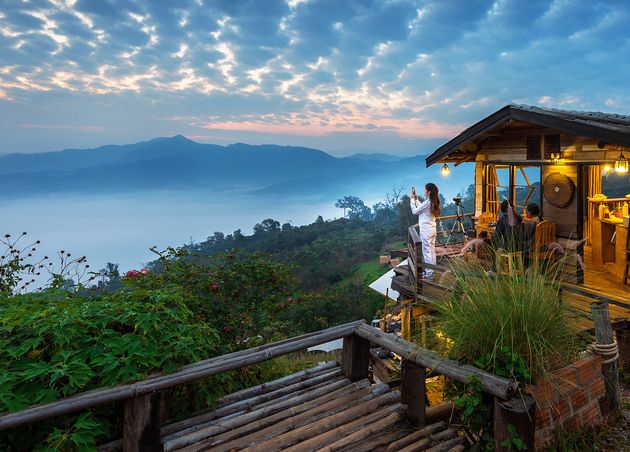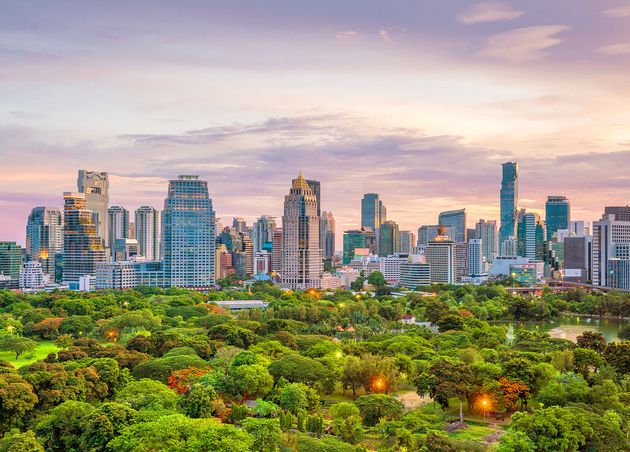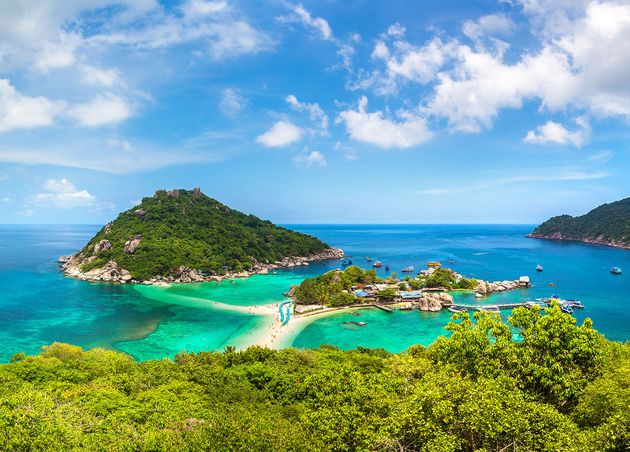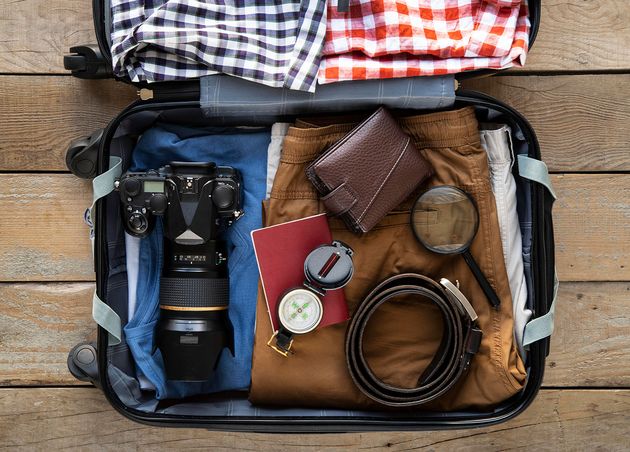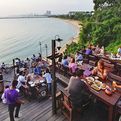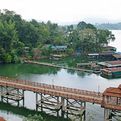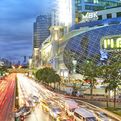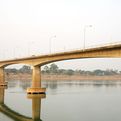Worst Time to Travel Thailand: A Complete First-Timer's Guide
Are you looking for the worst time to travel to Thailand? Well, you can learn everything here. Because, If you want to collect the best memories, you must know and travel during the best weather and avoid the bad weather conditions in the country.
The climate of Thailand is hot and humid, with a long monsoon season. Thailand only has three seasons in the tropical climate zone - hot, cool, and wet. The hottest months in the country are April and May, while September and October are the wettest months of the year.
Explore the unfavorable seasons to steer clear of when planning a trip to Thailand. Check out our comprehensive guide for first-time travelers to avoid the most challenging times of visiting the country.
Best vs. Worst Time to Travel Thailand
- Hot season: between March to May
- Rainy season: between June to October
- Cool-season(best): between November to February
What you hope to do in Thailand and the weather you prefer may decide the worst time for you to visit Thailand. If you don't like heavy rain, cold, muddy environments, flooded roads, and mosquito bites, the worst time will be June to October. On the other hand, if you don't like the high temperature, severe sweating, skin damage, and such issues, the worst time to travel to Thailand would be March to May. So, you have to go over Thailand's seasons and all climates to determine the worst and best times to visit Thailand.
However, by hearing different issues about Thailand, it can be pretty overwhelming for those of you who are first-timers to select the worst times to travel to Thailand yet. Accordingly, to help you to pick the best travel durations and to avoid the worst periods when visiting on your trip to Thailand, we have decided to compose the ultimate list of climatic conditions and recommendations about Thailand here in this article.
Climatic Conditions in Thailand
The climate of Thailand is tropical, with three distinct seasons: hot and dry season ( March to April), wet season (May to October), and cool season (November to February)
However, due to its natural beauty, luxury hotels, and delicious foods, all at affordable prices, Thailand is handily one of the foremost travel destinations in the world. So, for those annoyed to escape Thailand’s prominent beauty, it may feel like no worst time to visit. But, if you would like to maximize the potential of your trip, it’s essential to consider the influence of Thailand’s climatic conditions and peak visitation periods.
With such a varied landscape throughout the country from North to South, the climate in Thailand generally varies from region to region. Therefore, once you plan your trip to Thailand, you'll generalize it with the main seasons. There are many delightful times of the year to go to, so you want to think accordingly. Furthermore, the seasons in Thailand are not as straightforward as in other places in the world. So, we’re going over the seasons of every region to assist you in identifying the briefest time to visit Thailand for your travel needs! Traveling in all seasons has both advantages and disadvantages, and as with any destination, the weather is never as foreseeable as we’d like.
From all the seasons, you'll already guess which is the worst time of the year to visit Thailand: the hot and rainy seasons. For those who dislike rain, the worst time to visit Thailand is June to October. This is when the monsoon season peaks and blows from all directions. The streets also get flooded with rainwater – making it a little inconvenient when you want to tour the cities. It can also get chilly during this period.
During the rainy season, it is likely to rain for about an hour each day with occasional monsoons causing hours-long rains plus, the high will be around 89℉ (32℃) and the daily low around 78℉ (25℃).
Mid-March to late June is often ‘the worst’ regarding warmth. Throughout the hot season, temperatures exceed 30℃ with immediate-sweat humidity. However, this is often the time of year when airlines and hotels will lure you in with amazing discounts and promotions. So it's up to you to decide if you're willing to touch the highly humid heat and rainy days in exchange for these attractive prices.
For more details, you can follow the below link to go through the climate guide in Thailand:
Although the best time to travel to Thailand is between November and April, it is considered the high season. While September is considered a low season, air travel to Thailand is much cheaper.
Hot & Dry Temperature in Thailand (March to April)
The temperature starts to increase in mid-January, peaking between March and April. It is not unexpected for temperatures to be over 30℃ in Northern Thailand or maybe touch the 40℃ mark in some cities. During these months, the average temperature in southern Thailand is 32℃. April is the hottest season of the year. You'll go anywhere in Thailand this season because of the low rainfall. The lukewarm climate in Northern Thailand vanishes, but beaches on both coasts still derive pleasure.
Rainy Season in Thailand (June to October)
Scorching conditions can last well into the rainy season, leading to an increase in humidity. Temperatures in Thailand's northern and central regions during the wet season are generally high. September is the wettest month of the year. On the west coast, rainfall can occasionally expand to 350 mm. It is vital to notice that it doesn't rain all day, even during the wet season.
Nature of Rain in Thailand during the Wet Season
In the beginning, the rain can be unpredictable. It may look like it will rain, but eventually, you end up with a few raindrops and generally an average climate. On the other hand, there are days when the rain doesn't stop, and there will be raging thunderstorms on other days.
In the middle of the rainy season, you can expect heavy downpours with thunder and lightning almost daily. It may rain all day with a mixture of light and heavy rain. In central and northern Thailand, it rains hard for a couple of hours in the morning and then for a couple of hours in the evening. Although it's not raining, the sky is overcast and humid air.
The rain can be pretty predictable in October. These heavy rains can sometimes cause flooding in lower areas and valleys, but they may disappear by the next day.
Cool Temperature is the Best in Thailand (November to February)
Thailand's peak travel season is during this period when it is cool and enjoyable to travel throughout the country. The northeast monsoon brings calm, refreshing winds that help retain temperatures down. There is little rain in most parts of the country between December and February. Temperatures range from 18 to 32℃ in Krung Thep Maha Nakhon (Bangkok) and other central and southern parts of Thailand. December is the cooler month of the year. As daily temperatures in Northern Thailand can average 21℃, think of bringing some warmer clothes.
The Best Time to Visit Thailand
The cool season (November to February) is the best time to visit Thailand. It has the most pleasant weather, and you can enjoy the fantastic Thailand Lantern Festival. The best time for diving in the Andaman sea will be February – April, and the Gulf Coast will have its best weather during the summer months. Accordingly, the best thing is to visit Thailand to avoid the worst times.
The Monsoon in Thailand
From July to October, the winds bring moisture from the Indian Ocean to the southeast Asian subcontinent. These winds cause the humid and wet weather that we associate with the rainy season and also cause some of the tropical storms that happen at this time.
During the monsoon in Thailand, the seas are very rough. So, swimming and watersports can sometimes be dangerous due to generally large waves and frequent storms.
Special Weather Conditions in Thailand
Thailand’s climate can be summarized by high temperatures, high humidity ranges, and a number of sunny days, except during the monsoon when most rainfall occurs.
- During the rainy season, you may experience very cold, freezing, and wet days in Northern Thailand.
- Heavy rain and wind as an extension of cyclones on other island areas.
- Occurrence of typhoons that hit the Vietnam coast.
- During the hot season, the temperature is hot due to the high humidity. (Average temperature 29-34ºC, but can go over 35ºC in several places.)
Diverse Weather Conditions from Region to Region
Let's go through climatic variations in some regions of Thailand: Northern, North-eastern, Eastern, Central, Western, South, and the Gulf Islands.
Northern Region: Chiang Mai
Chiang Mai is further north than Krung Thep Maha Nakhon (Bangkok), typically much drier, and the rainy season affects them. If you visit Chiang Mai during the rainy season, you will surely experience the downpours, but they usually occur for only a few hours in the late afternoon. When it rains, the city always offers numerous things to do, such as shopping, getting famous Chiang Mai massages, taking a cooking class, and visiting museums. When the north is dry and dusty during the hot season, the uplands can be even hotter than the central plains. If possible, avoid visiting Chiang Mai from mid-February through early April, as the burning season and air quality can be pretty bad.
The winter season, from November to February, is the best time to go and explore Chiang Mai, according to the weather. During that period, the temperatures are lower. Traveling up to the mountains might experience temperatures as low as 3°C. In addition, during this time, rain is rare, and you will experience low humidity. If you love walking, you will be very comfortable around the city. As the sky is blue, with pleasant surroundings, you will get the best experience when you decide to ride a motorbike. Another good thing is that you don't need to turn on the air conditioning at night.
It is better to bring all-weather appliances if you hope to get around by motorcycle and don’t leave out your summer clothes with you. As this is the best season to get stunning photos of Chiang Mai, don't forget your photography backpack. If you plan a trip in winter, you will catch the Loy Krathong festivities and see the Chiang Mai flower festival, which displays yellow and white chrysanthemums and damask roses, a variety found only in Chiang Mai, abound.
North-Eastern Region: Roi Et
Roi Et, the wet season is oppressive and overcast, and the dry season is humid, partly cloudy, and hot year-round. Over the year, the temperature typically varies from 63°F to 95°F and is rarely below 56°F or above 102°F. However, the best time of year to visit Roi Et for warm weather and outdoor activities is from late November to mid-February.
Eastern Region: Rayong, Pattaya
The climate of the Eastern Region of Thailand is tropical and hot all year round, with a dry season from December to April and a rainy season from May to mid-November due to the southwest monsoon. The rains are not heavy in May and September-October. This happens because the bulk of the rain is released on the Burmese west coast, protecting this area of Thailand. Some heavy rains can not be excluded from June to August, as rainfall remains around 95/120 mm per month during this period.
Before the monsoon arrives, we can see an increase in rainfall, although the amount of sunshine is good. The period before the monsoon is the hottest of the year. Pattaya can be reached by tropical cyclones and typhoons, which come from the east, usually from June to December, and generally affect the interior of Thailand. However, the best time to visit the Eastern region of Thailand goes from December to April, that is, in the dry season.
Central Region: Krung Thep Maha Nakhon (Bangkok)
The climate is hot all year round in the capital, Krung Thep Maha Nakhon (Bangkok). Between mid-November and January, the weather is good, with clear skies. In February, temperatures start to rise. But, occasionally, a few short thunderstorms can develop. Before the arrival of the monsoon, the heat becomes intense. The capital is more humid because of the proximity to the sea.
Around mid-May, the monsoon arrives, and the temperature starts to decrease. During this period, the weather is often cloudy, and the humidity rises further, but at least the rains, in the form of showers and thunderstorms, sometimes intense, bring relief. In Bangkok, the amount of sunshine is perfect in the dry season. The best time in Bangkok is from December to mid-February since it is the least hot and outside of the rainy season.
Western Region: Kanchanaburi
In Kanchanaburi, the wet season is oppressive and overcast, and the dry season is muggy and partly cloudy. And it is hot year-round. Over the year, the temperature typically varies from 68°F to 98°F and is rarely below 61°F or above 104°F. Based on the beach and pool score, the best time of year to visit Kanchanaburi for hot-weather activities is from late November to mid-March.
On average, the temperatures are always high in the western region of Thailand. A lot of rain falls in May, June, July, August, September, and October. And the warmest month is April, while the coldest month is December. September is the wettest month. This month should be avoided if you are not a big fan of rain. In addition, January is the driest and sunniest month in Kanchanaburi.
Southern Region: Phuket, Krabi
In the Southern Region, the rainy season differs from the rest of Thailand. Phuket experiences the highest rain during September and October. If you visit during the other months of the wet season, you will probably experience some rain, but most days will have good weather.
Even on clear days, strong winds will make the waters too rough for swimming. However, during the rainy season, Phuket has many different options to keep visitors entertained, including some good museums and an aquarium on the island that is pretty cheap and offers a lot to see.
Gulf Islands: Koh Samui
In the Gulf Islands, the climate is tropical and hot all year round, with a long rainy season due to the monsoon of Southeast Asia. It runs from May to mid-January and a drier season from mid-January to April. The driest months are February and March in Koh Samui. The temperature is high throughout the year.
During the rainy season, the sea in Koh Samui will be very rough due to the strong winds, so swimming and watersports aren't recommended. The boat ride to the island will likely be very bumpy as well. The Gulf Islands are affected by tropical cyclones and typhoons from the east.
The best time to visit Koh Samui is from the middle or the end of January through April. The worst time is that of the retreating monsoon, especially the month of November. This is not really about the weather but linked to it; note that in the upper North of the country, there is every year, usually from late February to mid-April, 'smog,' fine particle pollution due to deforestation fires. The air quality hits unhealthy levels due to this. And also, there may be an occurrence of haze in the Southern part of Phuket and Krung Thep Maha Nakhon (Bangkok) if people burn the sugar cane harvest.
Best Ideas and Safety Precautions when Traveling in Thailand
During Rainy Season
- In some places, jellyfish can be present in the water, especially during the monsoon season, as the rainy season brings them closer to shore. Check the waters for jellyfish before entering, as they may harm you.
- Visiting waterfalls may be risky during the rainy season because water can suddenly increase due to sloppy rocks. So, be careful and follow an experienced guide for your safety.
- Dengue poses a substantial public health threat during the rainy season in Thailand. As mosquitoes can spread diseases very fast, It’s essential to take steps to prevent bites. Apply mosquito repellent regularly, especially in the evening. Long clothes can also help to avoid being bitten. Mosquito coils can be useful for evenings.
During Hot Season
- Drink more fluids to prevent dehydration.
- Sunscreen and a hat are necessary during the hot season; don’t forget to apply sunscreen regularly.
- Think especially about protecting your eyes from harmful ultraviolet rays during the daytime. So, think of using quality sunglasses instead of buying low-quality but cheap sunglasses from shops like Ray-Ban copy. They have no protection for your eyes. So, it's better to bring quality products from your home country.
What to Pack When Traveling to Thailand
Clothes
- In the wet season, lightweight clothing, quick-drying fabrics are needed to dry efficiently, a sweater for when it gets cold, and non-slip shoes.
- You may need swimming kits, lightweight clothes, scarves, and white color clothes to protect yourself from sunburns during the hot season.
Other Accessories
Packing items will ensure high-quality products in preparation for some short rainy days. So, the Targus backpack with rain cover is the best one.
In addition, a waterproof phone case, a lightweight waterproof money and document holder, a waterproof torch, waterproof mosquito repellent (the rainy season is also mosquito season), a small, flexible umbrella, and a small first aid kit will be helpful for you. Finally, there are some hotels which provide special offers during the above worst seasons. So, be aware of those good chances before visiting Thailand.
Overall, Thailand is typically good to visit at any time of year. But it’s good to travel to Thailand in November-January. The temperature will not be scorching during this time, but it will be warm. The summer months of June, July, and August are also not so bad besides the best time, which is November-February, but avoid March and April because the days are unbearably hot. September and October are okay, but you could be on significant rain-lasting days. Also at that time of year expect some rain every day.
Then, we organized the best times to travel to Thailand and listed the worst climates in Thailand that you should avoid. So, we hope reading through these suggestions will help you decide the best time and avoid the worst to visit Thailand.
Monsoon
: a prevailing seasonal wind in the region of South and SE Asia, blowing from the South-West between May and September and bringing rain (the wet monsoon) or from the North-East between October and April (the dry monsoon)
Muggy
: unpleasantly warm and humid weather
Overwhelming
: very significant in amount
Scorching
: very hot, harsh, or severe
Unpredictable
: not able to be predicted; changeable
Dr. Theodore (Professor Bear)
Hi! I'm Dr. Theodore Bennet (Professor Bear), your scholarly travel companion who brings history to life with immersive tours and expert guides. With a Ph.D. in History and years of travel writing experience, I offer authoritative insights for unforgettable journeys.
The Bear Travel | Experience like a Local
A fast-growing Thailand Travel Blog written by Expats and Thais since 2017. We will share our experiences and ideas from an insider point of view for you to create your own unique Thailand experience.
For the latest news and events about The Bear Travel, follow us on Facebook, Instagram, Twitter, Pinterest, or YouTube.
For any issues, concerns, or queries, don’t hesitate to CONTACT us.
Recommended for you
Rimpa Lapin: A World-Class Restaurant in Pattaya
Tle (Hungry Bear)
Sangkhlaburi: The Complete Guide to Exploring All The Stunning Bridges
Dr. Theodore (Professor Bear)
Best Countries for Digital Nomads: Finding Remote Work and a New Home
Marc Tubelleja (Curious Bear)
Maximizing Shrimp Farming with Top IoT Systems: A Complete Review
Riley Sinclair (Digital Aqua Bear)


